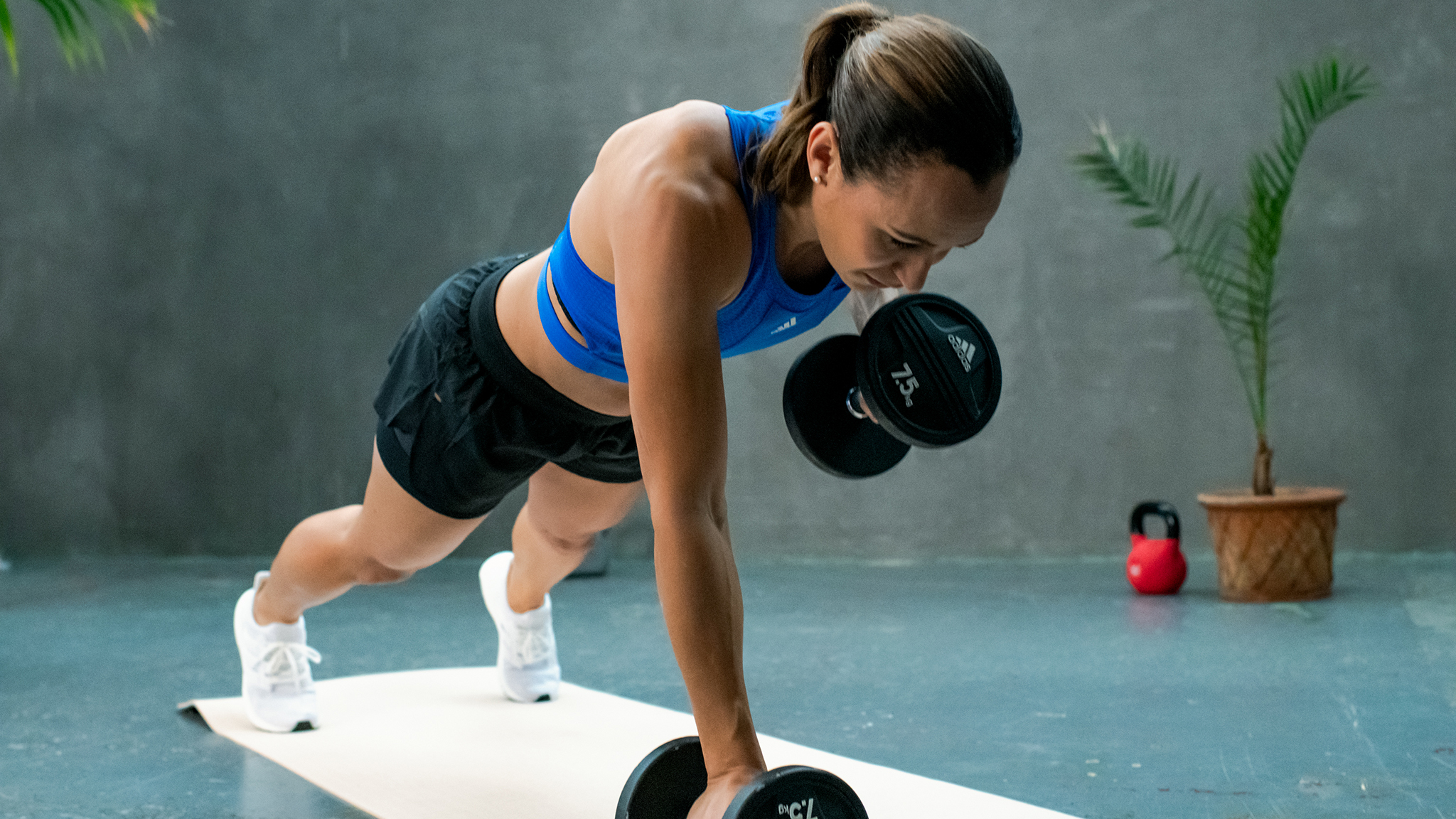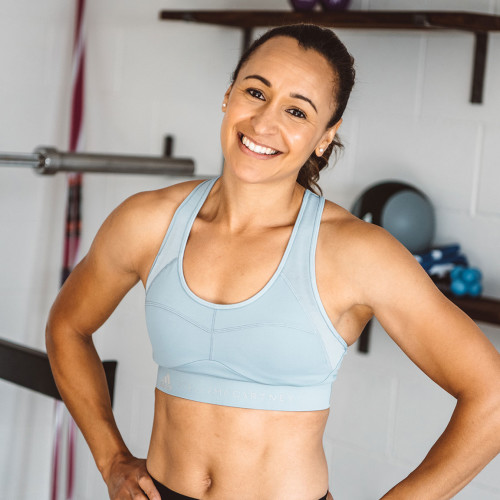All your strength questions answered with Jess Ennis-Hill
2 years ago
Training2 years ago
Training
Whether you’re starting from scratch, looking to get back into weights or you want to up your strength game, then we’ve got you covered…
Strength and resistance training has incredible body benefits, increasing bone density, revving up your metabolism, upping your running pace and so much more. But when you’re short on time, it’s often easier to pull on your trainers and go for a blast round the block instead.
With a third of us feeling like our strength has declined over the last two years and a natural muscle mass decrease of 3-8% per decade after the age of 30, it’s definitely time to add strength to your sessions. But, where do you start, how do you structure your sets, what kit do you need and what if you're a runner?
Here, Jess Ennis-Hill, Olympic heptathlete and founder of Jennis , answers all your strength questions big and small – just scan below to find the section that suits you.
How do you begin from absolutely nothing?
To create a strong base, I’d start with some low-level core activation exercises. Your stomach muscles are essential for form and posture and if you get these firing first, it will give you a great foundation for everything else. When you’re ready, you can slowly increase one thing at a time, either adding weight or increasing the duration of each session.
How do you make it a habit?
Try starting small with 10-15-minute sessions and build up from there. Even a 5-minute blast or 9-minute HIIT is enough to keep you motivated and stick with it. It will also give you a good base to build from. My other top tips are to plan your training schedule ahead of time and put your kit out before bed. By limiting the mental barriers to getting going, you reduce the risk of getting distracted and you’re more likely to follow through on your session.
Where should I start to ensure good form?
Form is super important, so always focus on getting your posture and form right before you go for all-out effort. Once you feel confident that your technique is spot-on, you can increase the pace and up the reps. Using a mirror is another really helpful way to make sure your form is right.
Most efficient strength exercises to fit into a busy schedule?
I love variations on lunges and squats as they address the big muscles, there’s little equipment needed and you can do them at home or in the gym.
Using a theraband adds that extra bit of resistance and keeps lots of important smaller muscles switched on.
Best strength sessions for runners?
Strength training as a whole is a great addition to any running programme as it prevents injuries, encourages better posture and helps you run faster. It’s also the thing that a lot of runners neglect.
My favourite simple exercise to include post-run is walking lunges as they’re great for building strength in your hamstrings, quads and glutes. You can read more about how strength training will make you a better runner here .
Did you have any go-to strength exercises when you were competing?
To build up explosive strength which I needed for most of my events, hang cleans were my go-to. They’re amazing to build strength, power, speed and performance, but it’s really important to have your technique nailed otherwise you risk injuring yourself. I love plyometric exercises too, like bunny hops, jumping lunges and jump squats.
How can you work your strength sessions around your menstrual cycle?
Planning your training around your menstrual cycle is a real game changer and can definitely lead to bigger training and lean muscle gains.
During your Follicular Phase (which kicks in after your period), for example, you recover faster, your muscles adapt better and you feel less fatigued. Not only do you feel more motivated when it comes to your strength work, but studies show that you can make up to 15% more lean muscle gains if you do more strength work here - rather than spreading it evenly across your whole cycle. In my Jennis CycleMapping programme we help you identify when it's best to work strength training into your cycle, when it’s good to do HIIT, when to rest and so on - all aligned to your hormonal profile.
Does weight training make women bulky?
Because of our hormonal makeup, it’s actually really difficult for us to get bulky and takes a lot of hard work, with the majority of women more likely to become lean, strong and powerful. You can read more about why this is here .
How often should I strength train and how long should each session be?
This really depends on your goals and fitness level, but if you’re just starting out, then adding dumbbells into a HIIT or LISS session is a great way to get going. Once you’ve developed a good technique you can up the weights and/or increase the intensity. I’d start with a 30min strength session once a week and go from there.
Can you do strength training exercises every day?
It’s really important to take a day or two off across a week of training. It’s these rest days where you actually build up muscle and get stronger , so they’re a key part of any training routine. I’d suggest planning a mix of strength and cardio 4-5 days a week, then scheduling your rest days in between.
How many reps should I do for each exercise?
When it comes to reps, you need to factor in both your fitness level, the level of resistance you’re working with and your goal.
If you’re training with heavy weights and looking to build muscle, then go for 8-12 reps, with the final rep pushing you to fatigue (the point at which you can’t do another rep).
If you’re working with lighter weights and looking to build lean muscle, you can do 15+ reps or even do your strength against the clock. I often do my strength sessions against the clock to help me get in the zone, then adjust my reps and weights accordingly.
How many sets of each workout should I do?
If you’re just starting out then it’s important to focus on your form before the number of sets you’re doing, but as a guide, 2-3 sets is a good starting point. As you build on your strength, you then can start to push yourself and up the sets. Yet again, it depends on your fitness level and goal though.
My Jennis HIIT (bodyweight resistance) sessions tend to be 4 sets of 7 exercises with a minute rest in between, while my strength sessions are 3-4 sets of 7 exercises.
How long should I rest between sets?
This all depends on your goals and level of resistance. If you’re using heavier weights for less reps to build strength, then you can take as long as 3 minutes between sets to give your muscles a chance to recover and come back stronger.
If you’re working with mid-level weights then you can up the reps slightly and take shorter rest periods (1-2 minutes), and if you’re going for lighter weights with high reps to build endurance then take a 30-second rest.
The key is to not skimp on the rest periods as these allow your muscles to recover and adapt.
When and how often should I up the load?
Always make sure that you’ve really nailed your form before increasing the weight. If you complete a session where you felt really comfortable with your form and the level of resistance, then try upping the load next time.
You might find that you fatigue quicker when you do add more weight though. If that’s the case, then don’t push it, reduce the reps and focus on keeping your technique strong.
What's the best time of day for a strength workout?
This is totally dependent on you and your schedule. Every person is different, so I always say to fit in your workouts when it suits you best. Just try not to workout too close to bedtime as it can keep you up at night and affect your sleep patterns.
How long should I have achy muscles after a session?
As strange as it might sound, Delayed onset muscle soreness (DOMS) is actually a good thing as it shows that you’re getting fitter and stronger.
Having these for a day or two after a workout is totally normal and it’s a sign that your muscles are recovering and building back stronger than before. Make sure to rest if you do feel stiff or achy though, as you’ll avoid injury and allow your body to repair fully.
Where would you fit in strength? I work full time and run 6 days a week, so I struggle to find time.
I’d start by substituting one run a week with a strength session. Adding strength training into your running programme will actually help to improve your performance so it’s a win win and will add some variation to your weekly routine too.
How do you keep strength training interesting/fun?
To keep things interesting and keep challenging my body, I try to mix it up as much as possible. Sometimes I’ll do a HIIT session with some light weights and other times I’ll do a rep-based strength session.
Bodyweight-only resistance sessions, where you use your bodyweight to add load as opposed to weights, are also great. Think squats, burpees and tricep dips - and you’ll know exactly what I mean.
How do you get motivated after some time out?
Motivation is always a hard one and I definitely have times where I struggle. Reminding yourself of your short term goals and thinking about how great you’ll feel after always helps. Don’t forget to listen to your body too. If you’re not up for the workout you had planned, then try something new instead. You’re likely to work harder and get more out of it if it fits your levels of energy and motivation.
What if I don’t have any weights at home? Can I still do strength?
Yes! All you need is your bodyweight. Exercises like press-ups, jumping lunges, planks and cross body mountain climbers work multiple muscles in one go and build on your full body strength.
You can also use water bottles or cans of beans in place of dumbbells as you build up your strength and want a bit more of a challenge.
Best bodyweight strength exercises without equipment?
Tricep dips, squat jumps, burpees and cross body mountain climbers are real strength builders - and require zero kit, while working multiple muscles. I’ve rounded up my top 7 no equipment bodyweight exercises here .
When’s the best time to eat after a strength session?
It’s best to have a post-workout snack within 30-minutes of completing the session so that your muscles have the nutrients they need to replenish and grow stronger.
Try to plan a meal 2-3 hours before you train too, so you’re topped up with energy and ready to go. And if you tend to work out first thing, then aim for a nutritious evening meal the night before. Your dinner should ideally be 50% good quality carbs like oats, quinoa or brown rice, then split the other half between protein, a small amount of healthy fat and vegetables or salad.
Will protein help me build lean muscle?
Protein is great for muscle build and repair, however carbs are the nutrients that allow us to refuel, so the key is to have a good mix of both. Aim for a ratio of 3:1 carbs to protein post-workout. Some easy snack options are a yoghurt based smoothie with seeds and fruit, a handful of nuts or rice cakes with peanut butter.
What do you eat to fuel yourself before or after a strength session?
If I’m working out in the morning then I’ll start with a coffee and a loaded bowl of homemade granola, greek yoghurt, berries and bananas with a drizzle of manuka honey. Then post workout I’ll either have eggs or a multigrain salad with sweet potato and loads of colour from whatever veggies I have in the fridge.
 Cycle syncing
Cycle syncing Perimenopause
Perimenopause Perimenopause
Perimenopause Perimenopause
PerimenopauseSign up to learn everything you need to know about CycleMapping, plus how you can live better and feel better through optimising your fitness to you.
This website uses cookies to ensure you get the best experience on our website. Learn more

Sign up for the very latest news on women's fitness, health and hormones, plus be the first to receive exclusive offers and extras